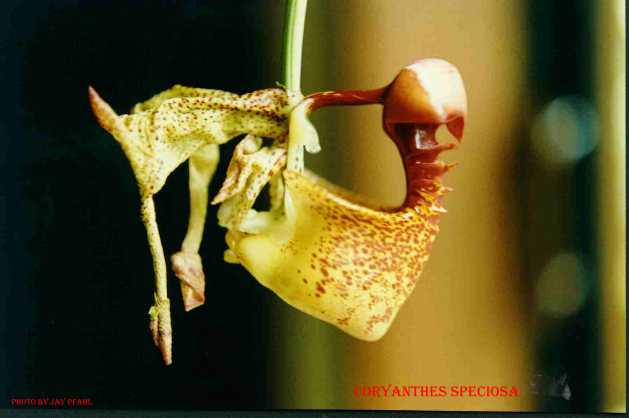

SUBFAMILY Epidendroideae, TRIBE Gongoreae, SUBTRIBE Stanhopeinae. The genus Coryanthes has 30 species in the new world from Guatemala to Bolivia. It is a difficult genus because of it's rarity in nature as well as in cultivation. It was first described by Hooker in 1831 and he used C. maculata as his type species. Coryanthes has large ribbed pseudobulbs with 2 or 3 thin veined leaves. The inflorescence arises from the base of the pseudobulb and hangs straight down through the medium. For this reason a wire basket or mounting on a slab of tree fern is mandatory to accomodate the bloom spike.
One of the most complex flowers of the orchid family is seen in the genus Coryanthes.
The parts of the Coryanthes flower are, the epichile {#1}, faucet gland or pleurida {#2}, mesochile {#3}, hypochile {#4}, pedicel {#5}, lateral sepals {#6}, dorsal sepal {#7}, petals {#8}, entrance to the stigmatic cavity {#9}, and the pouch like bucket or labellum{#10}. The flower bud of Coryanthes is quite interesting and has the appearance of the man in the moon.
Coryanthes grow in antnests in lowland humid and wet forests up to 1200m. The genus is found in conjunction with mud antnests, of the ant genera Camponotus and Azteca, that resemble hornets nests around a branch of a large tree. They are also normally found with Epidendrum Imatophylum Lindl and the non-orchidaceous Peperomiaceae and Gesneriaceae to list a few.
Coryanthes are pollinated by Male bees of the genera Euglossa, Eulaema and Euplusia are the sole pollenators of the Coryanthes. They are attracted to the plant by the flower's heavy odor. The bee lands on the hypochile and searches for the fragrance compounds. When the bee goes below the hood it looses it's footing on the hard waxy mesochile surface and falls into the bucket which is filled with a mucilaginous liquid which the plant secretes from the pleuridia, or faucet gland, which is at the base of the column. The bees only escape is to crawl through the tunnel formed by the epichile of the lip and the column. The bee first topuches the stigma and then the gluey viscidium which attaches to the back of the bee. The most incredible part of this process is that the same bee has to go and fall into a flower again to achieve pollination.
Coryanthes Species List
The Illustrated Encyclopedia of Orchids by Alec Pridgeon. Published by the Timber Press The Manual Of Cultivated Orchid Species By Bechtel, Cribb and Launert, Published by The MIT Press
Native Colombian Orchids Volumes 1-6 Published by Editorial Colina By the Colombian Orchid Society
An Introduction to the Orchids Of Mexico By Andrew Wiard Published by Comstock Cornell Orchids Of Brazil By Jim & Barbara McQueen Published by Timber Press
Field Guide to the Orchids of Costa Rica And Panama By Robert L Dressler Published by Comstock Cornell
Orchids of Guatemala and Belize By Oakes Ames And Donovan Correl Published by Dover
~albertinae Karst, xuelas - See C. maculata
~balfouriana Hort. ex Sander - See C. Bruchmulleri Rchb.f
~biflora Barb, Rodr. - See C. bruchmulleri
~elegantissima Mast. - See C. elegantium
~maculata [Hkr.] - See C. speciosa
~maculata lindl. - See C. speciosa var punctata
~var albertine Lindl.- See C speciosa var punctata
~var fournieri Andre- See C. speciosa var punctata
~var parkeri Hkr.- See C. speciosa var punctata
~var punctata Lindl.- See C. speciosa var punctata
~var speciosa Andre - See C. speciosa
~var splendens Cogn.- See C. speciosa
~var vitrina Rolfe - See C. speciosa
~var vittelina Morren - See C. speciosa var vittelina
~picturata Rchb.f. a variant of C. speciosa - Belize -
~powellii Schltr. - See C. maculata
~punctata Beer - See C. speciosa var punctata
var alba Lindl. -
var espiritosantense Ruschi
var exima Cogn.
var punctata [Beer]Gerlach
var sumneriana Gerlach
var vittelina Morren
~splendens Barb. Rodr. - See C. maculata
~sumneriana Lindl. - See C. speciosa var sumneriana

The species list below was composed with information from the following sources.